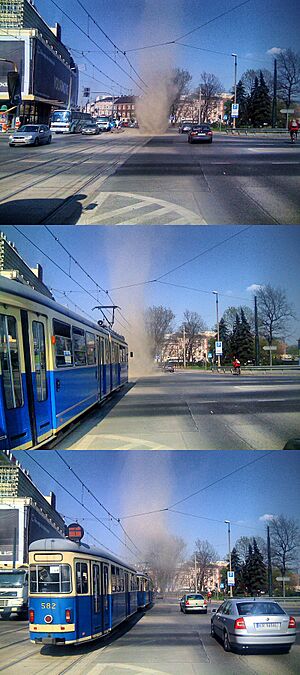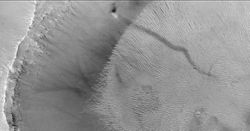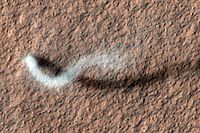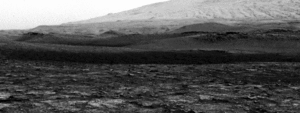Dust devil facts for kids
Quick facts for kids Dust devil |
|
|---|---|

A dust devil in Arizona.
|
|
| Area of occurrence | Primarily temperate and tropical regions. |
| Season | Most common in summer. |
| Effect | Dust and debris lofted into air, possibly wind damage. |
Dust devils are spinning columns of air that form in dry, hot places like deserts. They pick up dust and sand, making them easy to see. These swirling columns can be just a few feet tall or grow to over 3,000 feet (1,000 meters) high! Most dust devils are harmless. However, some can become strong enough to cause minor damage to things or even people.
Contents
How Do Dust Devils Form?
A dust devil starts when hot air close to the ground quickly rises. This hot air pushes up through a small area of cooler, lower-pressure air above it. If the conditions are just right, this rising air begins to spin. As the hot air moves upward, it stretches out vertically. This stretching makes the spinning get much faster, similar to how a figure skater spins faster when they pull their arms in.
The hot air cools as it rises. Eventually, it sinks back down to the bottom of the dust devil and spreads out. More hot air then rushes up the column to replace it. The air that sinks pushes out around the dust devil, helping to keep it balanced. This process keeps the dust devil spinning.
Certain things help dust devils form:
- Flat, dry ground: Flat areas with lots of heat make sure there's always hot air to "fuel" the dust devil. Dust and sand also make the dust devil visible.
- Clear or slightly cloudy skies: The ground needs a lot of sunlight to heat the air.
- Light or no wind, and cool air higher up: Without cool air above and hot air below, a dust devil won't form. Strong winds can also stop a dust devil from staying stable.
A dust devil "dies" when it sucks in cool air from the ground. Cool air stops the hot air from rising, which makes the dust devil disappear. This usually happens when the dust devil gets weak or moves over a cooler area.
How Big and How Long Do They Last?
Most dust devils on Earth are small and not very strong. They are often less than 3 feet (0.9 meters) wide. Their winds usually blow around 45 miles per hour (70 km/h). They often vanish less than a minute after they form.
But sometimes, a dust devil can grow very large and powerful. Some can be up to 300 feet (90 meters) wide. Their winds can go over 60 mph (100 km/h) and they can last for more than 20 minutes before fading away.
Are Dust Devils Dangerous?
Dust devils usually do not cause harm. However, very strong ones have caused damage and even injuries in the past. For example, on September 14, 2000, a dust devil hit a fairground in Flagstaff, Arizona. It damaged tents and booths. Several people were hurt, but no one died. Experts believe its winds were as strong as 75 mph (120 km/h). This is similar to a weak EF-0 tornado.
On May 19, 2003, a dust devil in Lebanon, Maine, lifted the roof off a building. This caused the building to collapse, and a person inside was killed. In 2010, in El Paso, Texas, a dust devil picked up three children in an inflatable jump house. It lifted them over 10 feet (3 meters) high and carried them over a fence into a backyard three houses away. In 2018, in Commerce City, Colorado, a strong dust devil threw two portable toilets into the air. No one was hurt in that event. In 2019, a large dust devil in China lifted a bouncy castle, injuring 18 children and 2 adults, and sadly, two children died.
Dust devils have also been involved in about 100 airplane accidents. While many were minor, some have had serious results. They are also a risk for skydivers and paragliding pilots. They can make a parachute or paraglider collapse suddenly, which can cause serious injury or death.
Do Dust Devils Make Electricity?
Even small dust devils on Earth can create radio noise and strong electric fields. These fields can be more than 10,000 volts per meter. A dust devil picks up tiny bits of dirt and dust. As these particles spin around, they get an electric charge from rubbing against each other. The spinning charged particles also create a magnetic field that changes quickly.
These electric fields might help the dust devils lift material from the ground into the air. Studies show that a dust devil can lift about 1 gram of dust per second from every square meter it passes over. A large dust devil, about 330 feet (100 meters) wide at its base, can lift about 15 metric tons of dust into the air in 30 minutes.
Giant dust storms that sweep across deserts add about 8% of the mineral dust to the atmosphere each year. But the much smaller dust devils, which are common in summer, actually lift about three times as much dust in total. When dust devils carry a lot of sand, they are sometimes called sand pillars.
Dust Devils on Mars
Dust devils also happen on Mars! They were first photographed by the Viking spacecraft in the 1970s. In 1997, the Mars Pathfinder lander even detected a dust devil passing over it.
Martian dust devils can be huge. They can be up to 50 times wider and 10 times taller than dust devils on Earth. Very large ones might even be a danger to the robots and equipment we send to Mars. On November 7, 2016, the Mars Orbiter Mission photographed five dust devils on Mars. They were between 0.5 and 1.9 kilometers (about 0.3 to 1.2 miles) tall!
On March 12, 2005, scientists watching the Spirit rover on Mars reported something amazing. A dust devil passed over the rover and cleaned its solar panels! This greatly increased the rover's power, allowing it to do more science work. A similar cleaning had happened before with the Opportunity rover, and dust devils were thought to be the cause then too. Scientists think the electrical activity in dust devils might cause lightning on Mars, but this hasn't been fully proven yet.
Other Names for Dust Devils
In Australia, a dust devil is also called a "Willy-willy." In Ireland, dust devils are known as "Shee-gaoithe" or "Fairy wind."
What Else Is Like a Dust Devil?
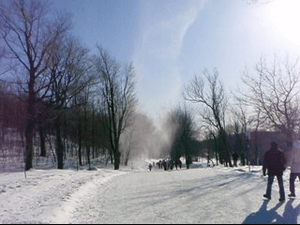

Fire whirls (or fire devils/fire tornadoes) can be seen during very hot fires, like in burning buildings or forests. A fire whirl is a spinning column of burning gases. It forms in a similar way to a dust devil.
Hot ashes in areas that have recently burned can sometimes create many dust devils. The light weight and dark color of the ash can make these "ash devils" visible hundreds of feet in the air.
Steam devils are often seen in the steam rising from power plants.
The same conditions that make dust devils can also create a snow whirlwind. This happens when warm air rises through snow-covered areas.
Coal devils are common in Tsagaan Khad, Mongolia, a town with a lot of coal. They form when dust devils pick up large amounts of stored coal. Their dark color makes them look a bit like small tornadoes.
Related pages
See also
 In Spanish: Remolino de arena para niños
In Spanish: Remolino de arena para niños


